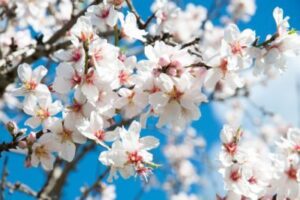This runs from 8:30 a.m. to 12:30 p.m, New York Academy of Medicine, 1216 5th Ave. Agenda to follow. Register here.

Almonds are great foods, and almond trees are beautiful, especially when in bloom (a lovely thought on a bleak winter’s day).

To produce almonds, the blossoms have to be pollinated, a job done by bees.
The bees don’t just appear spontaneously. Getting them to orchards is a for-profit business enterprise.
Most varieties of almond trees require cross-pollination – the transfer of pollen from one tree variety to another – to produce any nuts at all….Roughly 1 million acres of almond trees collectively bloom over a three-week period every February, creating spectacular scenic views but also putting enormous pressure on the farmers to pollinate them quickly. Each almond acre requires roughly two honey bee hives, each of which typically houses one colony of about 20,000 bees. With 2 million hives needed, that’s well more than half of the total U.S. hive population.
Unfortunately, trucking beehives around from one orchard to another is hard on the bees.
As The Guardian recently put it, using bees to fertilize almond orchards is “Like sending bees to war.” and “the truth behind your almond milk obsession” is deadly.
A recent survey of commercial beekeepers showed that 50 billion bees – more than seven times the world’s human population – were wiped out in a few months during winter 2018-19. This is more than one-third of commercial US bee colonies, the highest number since the annual survey started in the mid-2000s.
Beekeepers attributed the high mortality rate to pesticide exposure, diseases from parasites and habitat loss. However, environmentalists and organic beekeepers maintain that the real culprit is something more systemic: America’s reliance on industrial agriculture methods, especially those used by the almond industry, which demands a large-scale mechanization of one of nature’s most delicate natural processes.
FoodNavigator USA.com has issued a Special Report on this topic: “Bee friendly? Pollinating California’s almond crop.” It gives the almond industry’s view of the bee problem and its various causes.
The truth, as always, is more complicated, claims Dr Josette Lewis, director of agricultural affairs at the Almond Board of California, who likes to preface any conversation on this topic with the observation that almond growers are pretty motivated when it comes to ensuring honey bees are healthy and happy, given that it costs them almost $400/acre (two hives at c. $200 apiece) to hire these furry little pollinators upon which the success of their crop entirely depends. (To put this in perspective, it cost an average of $160/acre—two hives at c. $80 apiece – in 2005).
There is a “Bee-Friendly Farming” initiative among almond growers, but only about 10% are using it.
Regulation, anyone?